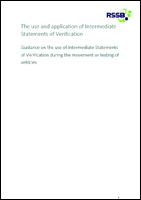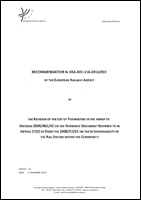National technical rules
From 1 January 2021, the Railways (Interoperability) Regulations 2011 (as amended), requires the Secretary of State to publish a list of all national technical rules (NTRs) that apply in the UK. NTRs are contained in Railway Group Standards (RGSs). The RGSs in the list replaces those that were previously notified national technical rules (NNTRs) prior to the ending of the transition period on 31 December 2020. Technical Specifications for Interoperability (TSIs) were replaced by NTSNs on 1 January 2021. For more information on NTSNs refer to National Technical Specification Notices (rssb.co.uk).
NTRs can be provided in situations such as:
- To fill identified 'open points' in NTSNs. Open points are identified in an annex to an NTSN if certain technical aspects corresponding to the essential requirements cannot be explicitly covered in the NTSN.
- To support ‘UK specific cases’ in NTSNs. A UK specific case is a special provision relating to the technical specifications for a subsystem or an interoperability constituent to allow for its compatibility with the rail system, which is set out in an NTSN or an NTR.
- To set out requirements to maintain technical compatibility between existing assets (or processes) that do not conform to the requirements of NTSNs and new, upgraded or renewed assets that do conform to NTSNs.
NTRs are not permitted to supplement the NTSNs on performance related issues or repeat requirements mandated by the NTSNs.
NTRs are intended for use by project entities on the GB mainline railway, as defined in the Railways (Interoperability) Regulations 2011 (as amended).
The industry process to be used for identifying and managing NTRs for the GB mainline railway is set out in the Railway Standards Code.
Publication of NTRs
On behalf of the industry, RSSB proposes a list of NTRs (standards) to the Department for Transport (DfT) that the Secretary of State considers for publication. The Secretary of State may publish additional requirements to ensure that all essential requirements are addressed by the NTRs.
NTRs are subject to periodic review as the status of the NTSNs changes and GB RGSs are developed or withdrawn. Current NTRs are published on the DfT’s website.
Guidance and clarifications to assist with application of NTRs
From time-to-time documents will be published to assist with application of NTRs. Documents that were published prior to 1 January 2021 (including those set out below) may refer to NNTRs and TSIs. These references should be read as NTRs and NTSNs. References may also be made to EU Directives, Regulations and Decisions which have been replaced or amended by EU Exit Regulations.
Applicability and relevance of RGSs and Rail Industry Standards
The Industry Standards Coordination Committee (ISCC) placed an action on RSSB and the Office of Rail and Road (ORR) to clarify when compliance with RGSs becomes compulsory under the Interoperability and licence regimes. A clear position was required to address any confusion in scenarios when a project is not in scope of the Railways (Interoperability) Regulations 2011 (as amended) thereby making requirements in RGSs not compulsory as NTRs, but at the same time potentially compulsory via the licence condition, or vice versa.
On 22 May 2018 ISCC considered the ORR sponsored paper which provided clarification regarding the applicability of Railway Group Standards (RGS) under the licence condition and when compliance with RGSs becomes compulsory. ISCC members were asked to communicate the advice in the paper to their constituents. The paper clarified that:
- The scope of current RGSs is limited to NTRs to support the Railways (Interoperability) Regulations 2011 (as amended). They are only compulsory when compliance is required for a change covered by those regulations. However, this does not remove the obligations on organisations, under the Railways and Other Guided Transport Systems (Safety) Regulations 2006 (as amended) (ROGS) or any other relevant regulations, to assess and apply industry standards (such as RGSs and RISs) based on suitable and sufficient risk assessments.
- In all other circumstances not covered by the Railways (Interoperability) Regulations 2011 (as amended), ROGS obligations continue to apply, including the need to consider all relevant technical and operational standards (such as RGSs, RISs, etc) and, apply them based on suitable and sufficient risk assessments.
ISCC and RSSB also recommended that the ORR should formalise the need for licence holders to comply with RISs. This is unless they have consulted with other affected parties and identified an equally effective measure which will achieve the purpose of the RIS. ORR progressed with this recommendation while updating Network Rail's licence conditions (see http://orr.gov.uk/rail/consultations/pr18-consultations/network-rail-network-licence-review-consultation-on-draft-network-licence for further details on the consultation).
See page on Emphasising the importance of Rail Industry Standards in licence conditions.
Note: Documents referenced in this section that were published prior to the UK’s exit from the EU and the ending of the transition period continue to remain applicable.
Recommended approach for identifying valid fire testing requirements for vehicles.
Based on discussions between the DfT, the ORR and RSSB, a proposed way forward was identified for projects seeking an authorisation to place in service from the ORR. Projects should follow the decision logic set out in Annex A of this document to identify the valid fire testing requirements applicable to their work. The proposed approach aims to ensure double testing is avoided by existing projects, which may be reliant on GMRT2130 or BS6853, while new projects can rely on EN16989:2018 for fire testing and on EN45545-2 for other fire tests relevant to vehicles.
The approach recommended in this document has been endorsed by the ORR.
Note: Documents referenced in this section that were published prior to the UK’s exit from the EU and the ending of the transition period continue to remain applicable.
Open points in NTSNs not closed out by RGSs
For some NTSNs, there are open points where the GB mainline railway does not have an NTR. That is, an RGS does not address the issue.
Where there is an open point which is not closed out by a RGS, the DfT requires each project entity that is doing work on the mainline railway which requires an authorisation to place in services to propose the project specific technical rules it intends to use to close out any such open points relevant to its project. Parties may seek observations and comments from the relevant standards committee(s) on the proposed way forward in accordance with 13.4 of the Standards Manual by completing this application form and submitting it to proposals.deviation@rssb.co.uk.
Intermediate Statements of Verification
An Intermediate Statement of Verification (ISV) is used by some projects after the design, construction, upgrade or renewal of a vehicle to demonstrate that the vehicle conforms to the relevant NTSN and/or applicable NTR before moving onto the final testing stage of the verification assessment procedure.
RSSB has produced guidance on the use and application of ISVs to:
- clarify what an ISV is and its role during the vehicle assessment, assurance and testing process;
- explain the legal framework concerning ISVs;
- make recommendations on how project entities and RUs should interpret the use of ISVs during the final testing stage of the verification assessment procedure; and
- give some examples of practical situations in which an ISV has been issued and what else needs to be done.




